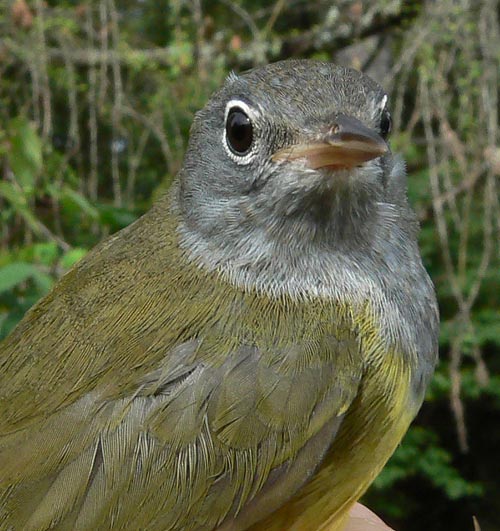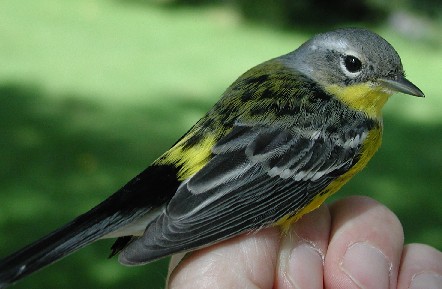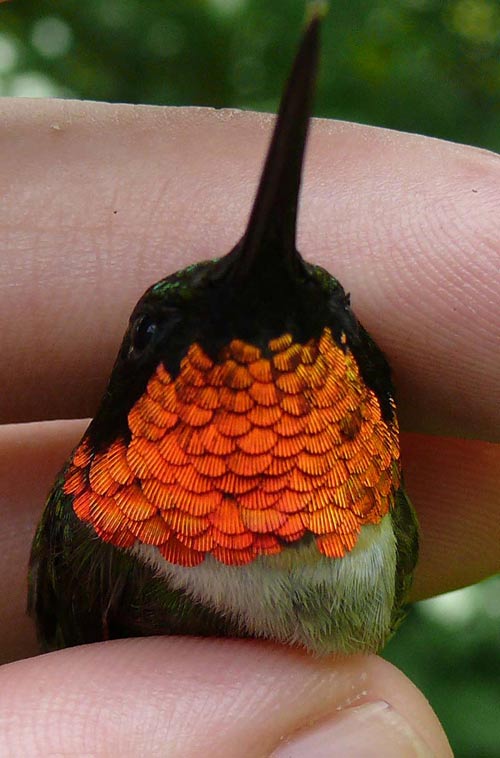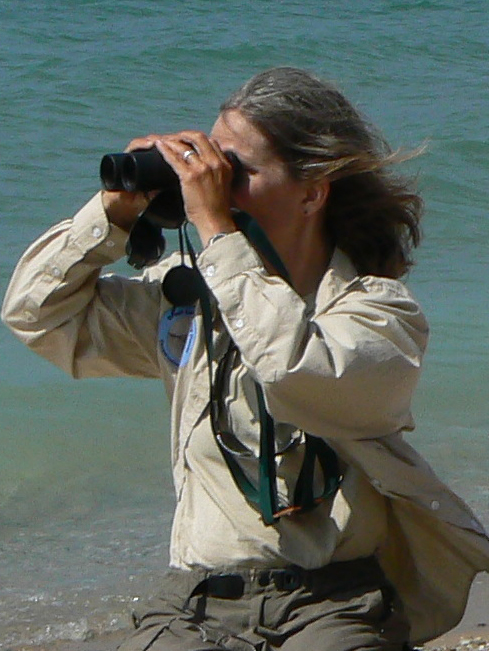Late September 2008

After-hatching-year male Connecticut Warbler

The end of September often includes some of Powdermill’s best days for both overall numbers and species diversity. During this period, September 20th was our best day in terms of species diversity (43 species) and total numbers (179 birds) of birds banded.
The most common bird on that day was the Magnolia Warbler, which accounted for 34 of the captures. September is when the majority of migrating fall warblers pass through western Pennsylvania.
The Magnolia Warbler is one species within a group known as the wood warblers, and western Pennsylvania hosts some of the highest diversity of these species in the world (in terms of both breeding and migrating). In fact, of the 116 species of wood warblers worldwide, all of these restricted to the New World, 53 species occur in North America, and 37 have been captured at Powdermill.
The plumage of some wood warblers can be similar to vireos (pine warbler and yellow-throated vireo), but an examination of the bill can readily identify a warbler (thin bill) from a vireo (stout, hooked bill).
Pictured is an AHY male Magnolia Warbler. Although plumage characteristics between the age and sex classes of the Magnolia Warbler can overlap, this bird’s extensive black on the back and uppertail coverts is typical of an adult male.

The Black-throated Green Warbler (pictured below) belongs to the genus Dendroica, which is a particularly colorful and diverse group of wood warblers (16 species in eastern N. America) and are characterized by wing bars, tail spots, and frequently have streaking on their breast and sides.
Like the Black-throated Green Warbler sexual dimorphism is common in this group of wood warblers. Adult males are generally the brightest colored and largest individuals while young females are typically the dullest and smallest ones. However, young males and adult females can often have very similar plumages and care should be taken when classifying these individuals.
AHY male Black-throated Green Warbler

We held an Advanced Bird Banding Workshop between September 24-28. Participants of this workshop included Richard Joos (bird bander at the Toronto Bird Observatory), Jennifer Wang (graduate student at the Albert Einstein College of Medicine), and Kristi Bowersox (field biologist).
Richard used the workshop to prepare for the North American Banding Council (NABC) certification that he took the following week. We were happy to hear that Richard successfully completed the exam and became certified as both a bander and instructor by the NABC.
During the 5 day workshop at Powdermill we banded 442 individuals of 57 species. Richard was very excited to capture several Connecticut Warblers, Kristi appreciated the avian diversity, and Jennifer enjoyed everything from the flowers to newts and of course all of the birds!
Pictured from left to right is Bob Leberman (Bander Emeritus), Jennifer Wang (workshop participant), Richard Joos (workshop participant), Andrew Vitz (banding coordinator), Alice Van Zoeren (banding assistant), Kristi Bowersox (workshop participant), Eugene Hood (visiting British bander), and Marja Bakermans (avian ecologist).

A bird’s bill is an extremely useful instrument, and much can be learned about a species just by examining the bill. A short, thin bill (warblers) is best for consuming insects, a long, stout bill (finches) for seed eating, and long, thin bills (hummingbirds) are common for nectivores.
However, many species change their diet seasonally. For example, Rose-breasted Grosbeaks primarily consume insects when breeding but focus on fruits and seeds during much of the year.
Studies conducted by Peter and Rosemary Grant on seed eating birds on the Galapagos Islands have revealed that bill size and shape are adaptations to the types of seeds that each species prefers. Interestingly, contrary to the popular belief that evolution is an extremely slow process, they found that evolutionary changes can happen very rapidly (within a season!) and even be observed by scientists.
However, selection pressure is not directional and can oscillate dramatically making evolutionary change appear to occur only over large periods of time. The fascinating, Pulitzer Prize winning book the Beak of the Finch (by Jonathan Weiner) is wonderfully written and describes in detail how changing environmental conditions can influence food availability and rapidly drive evolution (via natural selection) of bill size and shape.
Returning to birds of eastern North America … The Brown Creeper uses its thin, curved bill to capture small invertebrates from bark as it creeps up tree.

The diet of the American Redstart consists almost entirely of invertebrates. Notice that the redstart has a relatively broad and flat bill and well developed rictal bristles (modified feathers). All of these adaptations allow this species to efficiently capture insects by employing the technique known as flycatching.
This bird can be easily identified as an AHY male from its distinctly black and orange plumage. However, many adult warblers are characterized by rounded outer tail feathers while hatch-year birds typically have pointed outer tail feathers. Notice the very rounded shape of the outer tail feathers on this redstart.

The Rose-breasted Grosbeak will forage on a variety of food resources including insects, buds, and berries, and their massive bill allows them to crack and consume seeds. Look for this species at bird feeders when they are migrating through your region during spring and fall.

Notice the long, sturdy bill of the Green Heron. Such bills are typical of those found in the heron family and are used to spear fish.

Ruby-throated Hummingbird captures began to taper off as most of them have moved to our south as they head to their wintering grounds in Mexico and Central America. Amazingly, this migration takes them on a 600 mile nonstop flight across the Gulf of Mexico.
Although this is the only hummingbird that breeds in eastern North America, there are 340 species of hummingbirds throughout the Americas (restricted to the New World). Hummingbirds have an extremely high metabolic rate with up to 1200 heartbeats a minute and 70 wingbeats a second.
Therefore, these birds must forage continuously throughout the day and go into a state of torpor during the night in order to conserve energy. During late September, the most we captured was 5 on September 19. Hummingbird gorgets are often very colorful and these are termed structural colors (all blue and iridescent colors in birds).
These colors are not a result of pigmentation, but rather depend on the angle of the reflected light. This is why the gorget of the Ruby-throated Hummingbird may appear nearly black at some angles and brilliant red at others.

This fall we were fortunate to have Eugene Hood volunteer at Powdermill for 2 weeks. Eugene is a bird bander at the Sandwich Bay Bird Observatory in England www.sbbot.co.uk. It is always nice to learn about bird banding at other stations, especially those that are outside of North America.
Eugene is pictured holding one of the 5 Sharp-shinned Hawks that were captured at Powdermill this fall.

We also want to acknowledge the help of Alice Van Zoeren who spent a month at the banding lab during the peak of fall migration. Alice spends her summers on the shores of Lake Michigan studying the breeding biology of her favorite bird, the Piping Plover.
Despite her shorebird bias, Alice very much enjoyed the numerous migrating songbirds that used Powdermill as a stopover site to refuel before continuing their southern migration.
Alice is shown here watching a Piping Plover in Michigan


We captured our first Solitary Sandpiper of the fall on September 19. Following banding, it was spotted for several days foraging in the ponds within our banding station.
In the photo you can see the band on this bird’s leg. Below Another (albeit more secretive) bird that was found foraging in these ponds was the Sora. Although we did not capture any Soras we saw as many as 3 foraging at dusk in the same small pond and very close to our nets.
Top picture Solitary Sandpiper - Photo by Alice Van Zoeren
Bottom picture Sora - Photo by Alice Van Zoeren
We had lots of help during this busy time at Powdermill. Assistance was provided by Gerardo Rodríguez Ramos, Marja Bakermans, Alice Van Zoeren, Eugene Hood, Mary Shidel, Anna Maria Bakermans, Richard Joos, Jennifer Wang, Kristi Bowersox, and Jeff Territo. Additional help was given by Powdermill staff members including Bob Mulvihill, Bob Leberman, Mike Lanzone, and Cokie Lindsay. We thank all of these people for their time, and assistance.
